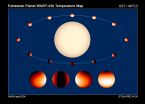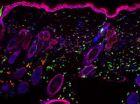(Press-News.org) A team of scientists including a University of Colorado Boulder professor used NASA's Hubble Space Telescope to make the most detailed global map yet of the glow from a giant, oddball planet orbiting another star, an object twice as massive as Jupiter and hot enough to melt steel.
The Hubble observations show that the planet, called WASP-43b, is no place to call home. It's a world of extremes, where winds howl at the speed of sound from a 3,000-degree-Fahrenheit dayside to a pitch-black nightside when temperatures plunge to a relatively cool 1,000 degrees Fahrenheit, still hot enough to melt silver.
The map provides information about temperatures at different layers of the planet's atmosphere and traces the amount and distribution of water present. The findings have ramifications for understanding the atmospheric dynamics and the formation of giant planets like Jupiter, said team leader Jacob Bean of the University of Chicago. "These measurements have opened the door for a new kind of comparative planetology."
A paper on the subject was published online Oct. 9 in Science Express.
As a ball of predominately hot hydrogen gas, there are no surface features on WASP-43b like oceans or continents that can be used to track its rotation, said CU-Boulder Assistant Professor Jean-Michel Désert, second author on the new study. Only the drastic temperature difference between the dayside and nightside can be used by remote observers to mark the passage of a day on the strange, gaseous planet, he said.
"WASP-43b is extreme in many ways," said Désert. "It's the size of Jupiter with twice its mass. Its orbit around its host star, called an orange dwarf, takes only about 19 hours – the blink of an eye compared to the 365 days it takes Earth to orbit the sun."
Désert said the study is compelling to those trying to understand planetary formation. "Basically it is like taking a planet like Jupiter into a giant laboratory, then warming it at such a high temperature that all of the atoms and molecules comprising its atmosphere are in a gas phase."
Another bizarre thing about WASP-43b is its orbit. It orbits so close to its host star it always "shows" the same hemisphere, a phenomena similar to the orbit of the moon around Earth that is known as known as "tidal locking."
Discovered in 2011, WASP-43b is 260 light-years away -- too distant to be photographed. But because its orbit is observed "edge-on" to Earth, astronomers detected it by observing regular dips in the light of its parent star as the planet passed in front of it, said Désert of CU-Boulder's Department of Astrophysical and Planetary Sciences.
"These observations allow us to determine the abundance of water in the planet's atmosphere, which is a major element involved in planetary formation," said Désert. "By measuring the composition of this planet, we will have a better idea where it formed within the proto-planetary disk of the host star."
The scientists combined two previous methods of analyzing exoplanets -- planets outside our solar system -- and put them together for the first time to study the atmosphere of WASP-43b. Spectroscopy allowed them to determine the water abundance and temperature structure of the atmosphere. And, by observing the planet's rotation, the astronomers were also able to measure the water abundances and temperatures at different longitudes.
Because there's no planet with these tortured conditions in our solar system, characterizing the atmosphere of such a bizarre world provides a unique laboratory for better understanding planet formation and planetary physics. Water is thought to play an important role in the formation of giant planets, since comet-like bodies bombard young planets, delivering most of the water and other molecules that we can observe, according to the science team.
In order to understand how giant planets form, astronomers want to know how enriched they are in different elements. The team found that WASP-43b has about the same amount of water as would be expected for an object with the same chemical composition as Earth's sun.
For the first time astronomers were able to observe three complete rotations of a planet, which occurred during a span of four days. This was essential to making such a precise measurement according to Désert, also a faculty member at CU-Boulder's Center for Astrophysics and Space Astronomy (CASA).
INFORMATION:
For images and more information about Hubble visit http://www.nasa.gov/hubble.
For more information on CU-Boulder's Department of Astrophysical and Planetary Sciences visit http://aps.colorado.edu. For more information on CU-Boulder's Center for Astrophysics and Space Astronomy visit http://casa.colorado.edu/.
-CU-
Contact:
Ray Villard, Space Telescope Science Institute, 410-338-4514
villard@stsci.edu
Jean-Michel Désert, CU-Boulder, 303-492-9641
desert@colorado.edu
Jim Scott, CU-Boulder media relations, 303-492-3114
jim.scott@colorado.edu
Hubble project involving CU-Boulder maps temperature, water vapor on wild exoplanet
2014-10-09
ELSE PRESS RELEASES FROM THIS DATE:
Researchers unfold new details about a powerful protein
2014-10-09
Using X-rays and neutron beams, a team of researchers from the University of California, San Diego School of Medicine, University of Utah and Oak Ridge National Laboratory have teased out new information about Protein Kinase A (PKA), a ubiquitous master switch that helps regulate fundamental cellular functions like energy consumption and interactions with hormones, neurotransmitters and drugs.
"Mutations in PKA can lead to a variety of different human diseases, including cancers, metabolic and cardiovascular diseases and diseases involving the brain and nervous system," ...
Researchers reveal genomic diversity of individual lung tumors
2014-10-09
Known cancer-driving genomic aberrations in localized lung cancer appear to be so consistently present across tumors that a single biopsy of one region of the tumor is likely to identify most of them, according to a paper published today in Science.
The study led by scientists at The University of Texas MD Anderson Cancer Center addresses the challenge of what scientists call genomic heterogeneity, the presence of many different variations that drive tumor formation, growth and progression, and likely complicate the choice and potential efficacy of therapy.
A landmark ...
Hubble reveals most detailed exoplanet weather map ever
2014-10-09
A team of scientists using the NASA/ESA Hubble Space Telescope have made the most detailed map ever of the temperature of an exoplanet's atmosphere, and traced the amount of water it contains. The planet targeted for both of the investigations was the hot-Jupiter exoplanet WASP-43b.
WASP-43b WASP-43b is a planet the size of Jupiter but with double the mass and an orbit much closer to its parent star than any planet in the Solar System. It has one of the shortest years ever measured for an exoplanet of its size -- lasting just 19 hours.
A team of astronomers working ...
GPA, GRE inadequate for evaluating non-traditional students for graduate school admissions
2014-10-09
COLUMBIA, Mo. – As more people in the middle of their careers decide to return to school to further their education, the number of students applying to graduate school programs across the country has reached a record high in the past decade. With record numbers of potential students applying to their programs, many graduate school admissions evaluators are working to develop stronger admissions criteria that assure they are admitting students who will succeed academically. Now, researchers at the University of Missouri have found that traditional measures such as ...
Unusual skin cancer linked to chronic allergy from metal orthopedic implant
2014-10-09
In rare cases, patients with allergies to metals develop persistent skin rashes after metal devices are implanted near the skin. New research suggests these patients may be at increased risk of an unusual and aggressive form of skin cancer.
Metal alloys help make orthopedic implants stronger and more durable. But people with sensitivity to these metals, which include nickel, cobalt and chromium, can develop chronic inflammation that promotes the development of skin cancers, report researchers at Washington University School of Medicine and Barnes-Jewish Hospital in St. ...
University of Maryland School of Medicine begins Ebola vaccine trails in Mali
2014-10-09
VIDEO:
Dr. Myron M. Levine, Director of the Center for Vaccine Development at the University of Maryland School of Medicine describes the Ebola vaccine testing taking place in Mali, West Africa.
Click here for more information.
Professor Myron M. Levine, MD, Director of the Center for Vaccine Development (CVD) at the University of Maryland School of Medicine (UM SOM), and UM SOM Dean E. Albert Reece MD, PhD, MBA, announced today that the CVD, in conjunction with its sister institution, ...
UCLA study finds link between neural stem cell overgrowth and autism-like behavior in mice
2014-10-09
People with autism spectrum disorder often experience a period of accelerated brain growth after birth. No one knows why, or whether the change is linked to any specific behavioral changes.
A new study by UCLA researchers demonstrates how, in pregnant mice, inflammation, a first line defense of the immune system, can trigger an excessive division of neural stem cells that can cause "overgrowth" in the offspring's brain.
The paper appears Oct. 9 in the online edition of the journal Stem Cell Reports.
"We have now shown that one way maternal inflammation could result ...
Endocrine-disrupting chemicals alter thyroid hormone activity during pregnancy
2014-10-09
Washington, DC—A new study in human placenta provides the strongest evidence to date that Endocrine Disrupting Chemicals (EDCs) can interfere with thyroid hormone action in pregnant women. The implication is that flame retardant chemicals called polychlorinated biphenyls (PCBs) can infiltrate the placenta during pregnancy and affect thyroid hormone activity at the cellular level, according to a new study published in the Endocrine Society's Journal of Clinical Endocrinology & Metabolism (JCEM).
PCBs were used in transformers and other electrical equipment, paints, ...
Cold exposure prompts body to convert white fat to calorie-burning beige fat
2014-10-09
Washington, DC—Exposure to cold temperatures can convert white fat tissue from the thighs and belly to beige fat that burns calories for heat, but this biological response is hampered in obese people, according to a new study published in the Endocrine Society's Journal of Clinical Endocrinology & Metabolism.
Known as brown adipose tissue (BAT), brown fat is a particular kind of fat tissue that burns energy and glucose to generate heat. Babies and small animals rely on brown fat to stay warm. Brown fat's energy expenditure helps to prevent obesity in rodents.
While ...
Drinking decaf coffee may be good for the liver
2014-10-09
Researchers from the National Cancer Institute report that decaffeinated coffee drinking may benefit liver health. Results of the study published in Hepatology, a journal of the American Association for the Study of Liver Diseases, show that higher coffee consumption, regardless of caffeine content, was linked to lower levels of abnormal liver enzymes. This suggests that chemical compounds in coffee other than caffeine may help protect the liver.
Coffee consumption is highly prevalent with more than half of all Americans over 18 drinking on average three cups each day ...



